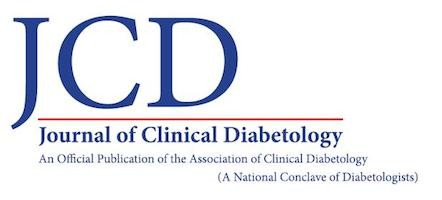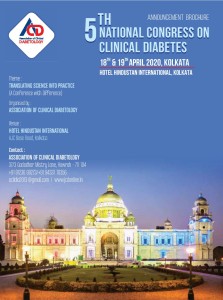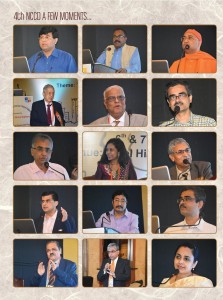
National Guidelines to Diagnose GDM
Prof V.Seshiah
Gestational Diabetes Mellitus (GDM) is defi ned as any degree of glucose intolerance with onset or fi rst recognition during pregnancy (1). Women with a history of GDM are at increased risk of future diabetes, predominantly type 2 diabetes, as are their children (2). GDM may play a crucial role in the increasing prevalence of diabetes and obesity (3). The highest prevalence was found in the South-East Asia Region at 25.0%. More than 90% of cases of hyperglycaemia in pregnancy are estimated to occur in low- and middle-income countries (4). Therefore all pregnant women should be screened for GDM, even if they have no symptoms, according to new recommendations (5). For this the diagnostic procedure has to be simple to perform, economical and evidence based.
Lessons Learned from Nirogi Maatha – Sri Lanka
Chandrika N Wijeyaratne, DBIA Jayawardane, DKNN Hemachandra, DBDL Samaranayake, MN Lucas, Kumudika Perera, Chamil Karunanayaka, Nadunika T Amarasinghe
The National Initiative to Re-organize General diabetes care In Sri Lanka (NIROGI Lanka), which is a project of the Diabetes Prevention Task Force Sri Lanka Medical Association is funded by the World Diabetes Foundation, and Nirogi Maatha (Healthy Mother) is one of its three components that commenced in 2012 as a part of the Phase II implementation of the initiative. NIROGI Maatha is committed to improving the quality of maternal diabetes care and in empowering communities to be responsible for the prevention of diabetes through the lifecycle and ensure optimal protection of the next generation. Multidisciplinary care and building tertiary and primary health care partnership is our priority with self-management of diabetes the focus. The focal point for maternal and child health (MCH) is the Family Health Bureau, Ministry of Health Sri Lanka, who is our main partner.
Is Screening and Integrated Care for Gestational Diabetes Cost Effective?
Anil Kapur
The National Initiative to Re-organize General diabetes care In Sri Lanka (NIROGI Lanka), which is a project of the Diabetes Prevention Task Force Sri Lanka Medical Association is funded by the World Diabetes Foundation, and Nirogi Maatha (Healthy Mother) is one of its three components that commenced in 2012 as a part of the Phase II implementation of the initiative. NIROGI Maatha is committed to improving the quality of maternal diabetes care and in empowering communities to be responsible for the prevention of diabetes through the lifecycle and ensure optimal protection of the next generation. Multidisciplinary care and building tertiary and primary health care partnership is our priority with self-management of diabetes the focus. The focal point for maternal and child health (MCH) is the Family Health Bureau, Ministry of Health Sri Lanka, who is our main partner.
Frequency of Gestational Diabetes Mellitus in Bangladesh Impact of WHO 2013 Screening Criteria : Effi ciency of DIPSI and WHO 1999 Criteria
Sandesh-Panthi, M A Hasanat,Mashfi qul-Hasan,Yasmin-Aktar, Nusrat-Sultana, Sharmin-Jahan, M Atiqur-Rahman, M Fariduddin
Prevalence of GDM ultimately refl ects the background rate of type 2 DM in the respective population (1,2). Along with the current epidemic of diabetes mellitus, the prevalence of GDM has increased worldwide over the last generation and occurs in 1% to 28% of all pregnancies, varying substantially between populations and the diagnostic criteria used (1,3). There has been much confusion internationally regarding the optimal method of diagnosing GDM. The consequent variability with regards to the optimal screening and diagnostic criteria haslimited the probability of comparison between different studies conducted (4, 5). In Bangladesh, a cross sectional institution based study completed in 2012 showed that the prevalence of GDM was 13.2% in the rural population as per the WHO 1999 criteria which is quite high (6).In contrast, a recent study inDepartment of Endocrinology,Bangabandhu Sheikh Mujib Medical University (BSMMU) has observed far higher frequency (over 40%) of GDM among pregnant women who were done OGTT irrespective of gestational age (29).
Screening for Gestational Diabetes Mellitus (GDM): Comparison between WHO 1999 and Modifi ed O’Sullivan Criteria
Nusrat-Sultana, M A Hasanat, Sharmin-Jahan, Sandesh-Panthi, Mashfi qul-Hasan, Yasmin-Aktar, M Fariduddin
For many years gestational diabetes mellitus (GDM) has been defi ned as any degree of glucose intolerance with onset or fi rst recognition during pregnancy though women found to have diabetes at initial prenatal visit should receive a diagnosis of overt diabetes not GDM (1).Screening for GDM is important as it is associated with adverse fetal and maternal outcomes and because these women and their children are at risk of developing diabetes mellitus (DM) in future (2,3,4).Female who have inherited genetic predisposition to type-2 DM, would be at higher risk of developing GDM during pregnancy (5). Specifi c risk factors and their degree of infl uence on GDM prevalence are diffi cult to quantify across populations. Recent data show that GDM prevalence has increased by ~10-100% in several race/ethnicity groups during the past 20 years
Correlation between Maternal Glycemic Status in Third Trimester of Pregnancy and Neonatal Birth Weight
Dr Ambarisha Bhandiwad, Dr Surakshith L Gowda; Dr Abhishek Bhandiwad
The prevalence of diabetes mellitus (DM) is increasing worldwide and more in developing countries including India. The increasing prevalence in developing countries is related to increasing urbanization, decreasing levels of physical activity, changes in dietary patterns and increasing prevalence of obesity. As women with gestational diabetes mellitus (GDM) and their children are at increased risk of developing diabetes mellitus in future, special attention should be paid to this population especially in developing countries.
Frequency of Post-partum Persistence of Glucose Intolerance in GDM Patients is Strikingly High at a Tertiary Care Hospital in Bangladesh
Sharmin-Jahan, M Fariduddin,Nusrat-Sultana,Yasmin-Aktar, Mashfi qul-Hasan, Sandesh-Panthi, M Atiqur-Rahman, M A Hasanat.
Gestational diabetes mellitus (GDM) affects 3% to 15% of pregnancies, depending on the population studied (1). Soon after giving birth, 90% to 95% of women with hyperglycemia in pregnancy are diabetes-free by 75g-oral glucose tolerance test (OGTT). By 6-12 weeks post-partum, 4% to 9% are diagnosed with type-2 DM, more than 20% have impaired glucose tolerance (IGT)
or impaired fasting glucose (IFG) or both (2). It has been observed that one third to one half of women with a history of GDM develop type-2 DM within 3 to 5 years and 70% will develop type-2 DM over 10 years having cumulative incidence of 2.6% to 70% (3). The effect of GDM extends beyond pregnancy for both the mother and child.
Gestational Diabetes Mellitus: A Public Health Approach
Dr. Vitull K. Gupta MD (Medicine), FICP, Dr. Varun Gupta, Meghna Gupta
As India completes 68 years of independence, there is no doubt about progress in the health status of its population, but still India is far from reaching the desired goal of health for all. However, over the past few decades, the country has experienced major transitions in economic development, nutritional status, fertility and mortality rates consequently accelerating the rise in the prevalence of chronic non-communicable diseases (NCDs). So India is now struggling to manage a ‘‘double burden’’ of non- communicable and communicable diseases necessitating a national public health care policy to combat both. A comprehensive strategy for the prevention and control of NCDs including Gestational Diabetes Mellitus (GDM) must integrate public health approach to minimize risk factor exposure of the population and individuals at high risk.
Journal Watch
The prospective analysis included 73 357 participants of the Kailuan cohort (57 719 men and 15 638 women). Resting heart rate was measured via electrocardiogram in 2006. Incident diabetes was defi ned as either the fasting blood glucose (FBG) 7.0 mmol/l or new active use of diabetes medications during the 4-year follow-up period. IFG was defi ned as a FBG between 5.6 and 6.9 mmol/l. A meta-analysis including seven published prospective studies focused on heart rate and diabetes risk, and our current study was then conducted using random-effects models.
Quiz
Announcement




